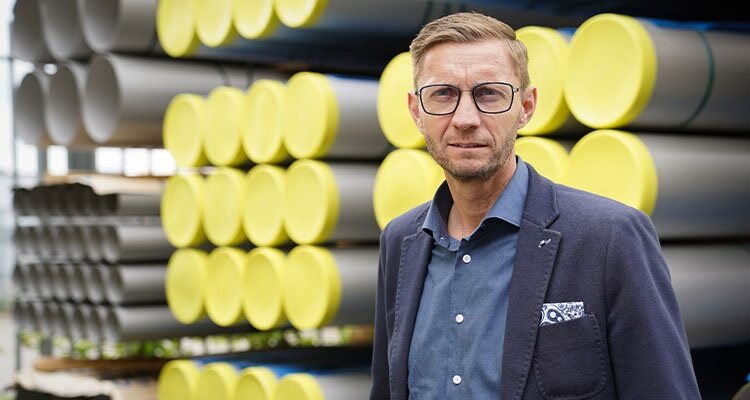
Damstahl’s game-changing climate calculator helps customers monitor carbon emissions
A renowned family-owned business, the Damstahl Group has carved a prominent niche in the wholesale industry as a specialist in stainless steel tubes, fittings, bars, and sheets. With a steadfast commitment to delivering top-quality stainless steel products, Damstahl has become a trusted partner for countless businesses across Europe. Operating in 11 countries, the company’s extensive reach ensures that its exceptional products are readily available to customers throughout the continent. Damstahl prides itself on its core values of integrity, reliability, and personalized service. Michael Lund, Group CEO, provides insights into Damstahl’s journey.
“Damstahl is part of the NEUMO Ehrenberg Group, a global player operating in three distinct business sectors: flow technology, specializing in pharmaceutical

hygienic fittings; food production on a global scale; and distribution of stainless steel and, as of the past year, aluminum and other metals. The NEUMO Ehrenberg Group traces its roots to Germany, originating in 1947 as Neue Molkereitechnik GmbH. It was founded by the German engineer and Senator Henry J. Ehrenberg with the mission to reduce the high child mortality rates in the post-war era. The stainless steel distribution activities began in 1960 with the establishment of Damstahl in Germany. In 1969, these activities expanded to Denmark, where the parent company now resides. Today, we stand as one of Europe’s largest independent and privately-owned stainless steel distributors, under family ownership. Last year, Damstahl achieved a revenue of 435 million euros,” he begins.
Henrik Ørskov, CPO and Supply Chain Director in the Nordic region, explains that Damstahl has recently merged the functions of purchasing, warehousing, and logistics. “On 1 August this year, we unified our management under my leadership, consolidating the traditional supply chain functions. This decision was prompted by several factors, including a generational shift when our previous warehouse and logistics manager for the Nordic markets transitioned to a different role. In addition, we aimed to streamline projects across various supply chain functions, improve communication, and ensure that actions in purchasing were aligned with inventory management, inbound processes, warehousing, and distribution. Our goal was to create more efficient project and process management throughout the entire supply chain.
“We had two primary objectives: firstly, to develop a more sustainable supply chain with a focus on reducing our carbon footprint, and secondly, to enhance our customer service. While our products, such as stainless steel, aluminum, and red metals, adhere to standard norms, and material prices remain highly transparent, we recognized that our service level could serve as a strategic differentiator. This involves considerations like how we package and deliver materials to our customers, providing an opportunity to differentiate ourselves while also adopting more environmentally sustainable practices,” Henrik enlightens.
 Optimizing distribution
Optimizing distribution
Dedicated to sustainability, Damstahl has embarked on initiatives to promote eco-friendliness, benefiting both the company and its customers. “From a supply chain perspective, our focus is on enhancing efficiency to reduce electricity consumption and transportation, and other actions that contribute to a poor carbon footprint. As part of our endeavor to reduce our carbon footprint, our buildings have been equipped with solar panels. Being a stockist, we source materials from Europe and beyond, storing and distributing them to customers. Transportation, a notable carbon emitter, significantly impacts our collective carbon footprint. Therefore, we’re concentrating on optimizing our distribution network to meet customer demand with fewer transport resources, ultimately reducing the number of lorries on the road each day. We have also brought in a transport and distribution manager to evaluate our various markets and develop a more sustainable distribution network without compromising customer service. This goal is mutually shared with our customers, as they also strive for greater sustainability, and collectively, we aim for a more sustainable world. We encourage our customers and suppliers to continually explore new and more sustainable production and transportation methods,” informs Henrik.
To help customers monitor their carbon footprint, Damstahl provides them with a climate calculator. “In 2019, we became aware of the need to provide sufficient evidence of carbon emissions and ensuring the accuracy of data we shared with customers became a priority. Thus, we engaged in extensive discussions with various suppliers to establish third party-validated data as a starting point. Once we had reliable data, we shifted our focus to effectively communicating this information to customers. For a few years, we had an adequate tool for this purpose, and then we enhanced it to create a more user-friendly tool known as the climate calculator. This tool is designed to assist our customers, especially as new regulations come into play. Companies with over 500 employees will soon be required to report their carbon footprint under the Corporate Sustainability Reporting Directive (CSRD). This means that our larger customers, whose customers are even larger OEMs, will need to obtain data from their suppliers. These reports encompass not only emissions from materials like steel but also other scope 3 emissions as well as scope 1 and 2 emissions. They must account for everything from cafeteria food to electricity usage and heating. Our climate calculator simplifies this process by calculating the direct emissions associated with our clients’ stainless steel and aluminum purchases,” elaborates Michael.
Damstahl is making strides towards its sustainability objectives through initiatives such as solar panel installation and optimized transportation to reduce emissions. The company’s commitment to empowering customers with reliable data enables long-term solutions for lower environmental footprints across the supply chain.